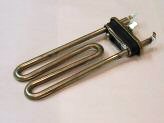|
Today tubular heating elements are used to heat a vast
assortment of appliances. In the catering trade and in
industry they can also be found in water heaters,
dishwashers, warming surfaces, grills and ovens. The
tubular heating element is highly versatile since it can
be produced in almost any shape and size. They can thus
be precisely matched to any application, and are
often the most economical solution even for modern
appliances.
Structure of the heating element
Inside the metal tube, a heater coil is embedded and
electrically isolated in highly compressed magnesium
oxide. The optimised structure and very high density of
the magnesium oxide form the basis for the excellent mechanical and thermal characteristics of the E.G.O tubular heating elements. They can also be fitted
with thermostats and temperature limiters in most
applications.
Tubular heating element dimensioning
The determining factors when dimensioning tubular
heating elements are the specific loads and the temperature limits of the heated material, the tube
shell and the heating conductor.
|
|

Typical formed heating element for Washing Machine
Custom - made features:
To
enable us to work out a proposal and a detailed
quotation for your heating element requirements, we need
various data.
If
possible, you should also provide dimensioned sketches
or drawings on a 1:1 scale, also we prefer pdf, dxf or
dwg data bases. Your specifications should contain the
following details, in particular: |

Typical 3.0Kwatt Fryer Element |
|
1.Application and medium
♦
Liquid (water, oil)
♦
Air
♦
Special medium (alkaline solution)
♦
Static or in motion (m/s)
♦
Type of mounting, direct or indirect
2.
Dimensions of tubular heating element and space
available for mounting, length of unheated tube ends.
3.
Wattage, voltage, alternating or three - phase current |
|
If
the heating element is accurately dimensioned, it will
operate reliably and over a long period. This also
requires the element to be installed correctly and have
an adequate outflow of heat. The temperature limits of
the medium and, if liquids are heated,
suitable protection against boiling dry should also be
considered.
DIN 44875 also includes recommended specific surface
loads.
Note: For
advise on your application and element design, please
contact our office were we will be pleased to assist
you.
Click Here for Stock Elements
|
|
4.
Type of connection
♦
Flex, insulated (e.g. PVC, silicone, glass fibre)
♦
Flex, bead insulated
♦
Flex with insulating tube (temperature - resistant)
♦
Plug - type connection, single (straight or elbow)
♦
Plug - type connection, double (straight or elbow)
♦
Pin connection with terminals
5.
Temperatures at connection area
6.
Type of fastening (e.g. flange, threaded nipple) |
